The Revisions
If the making of The Rite , of its music, scenario, and choreography, is complex and difficult to reconstruct, the stream of corrections, emendations, out-right rewritings and retractions that followed its initial performance is, regrettably, an even more tangled web of confusion, contradiction, and conflicting evidence.[38] No other work of Stravinsky's underwent such an extensive series of post-premiere revisions as The Rite . Here we can only hope to cover some of the highlights in the chronology, citing the more substantive changes in barring and scoring that will have a direct bearing on our analysis of rhythm and pitch structure.
To a large extent, the major changes can be examined simply by comparing the various editions of the score with one another and then by comparing these editions with the 1913 autograph, the 1913 four-hand piano version, and, in certain instances, orchestral drafts from the sketchbook. Unfortunately, such comparisons reveal only part of what is in the final analysis a much longer tale. Understanding when and under what circumstances specific alterations were introduced is an arduous task, and not all of the questions that subtly intervene are answered by studying the editions or the composer's own annotated copies of these, by consulting his correspondence with publishers and conductors (especially the letters to and from Ernest Ansermet during the 1920s), or by listening to his recordings of 1928, 1940, and 1960, and to those of Monteux and Ansermet. Stravinsky repeatedly changed his mind on a number of critical issues, and even after some of the more extensive revisions it is by no means always apparent just what his real or ideal intentions were; the role of the string pizzicato in the "Sacrificial Dance" is but one of the many cases in point. Often enough, adjustments were made as practical concessions to the difficulties encountered by specific performances.
Still, we can generally assume that the majority of the changes in barring and scoring were undertaken either to clarify the harmony and design (often by adjusting the orchestral balance) or, as indicated, to facilitate performance. Some of the more extensive rewritings do in fact coincide with celebrated performance dates. Thus, the Diaghilev revival of the ballet in December, 1920,
[38] Robert Craft has published three separate studies on The Rite 's revisions: "Le Sacre du printemps : The Revisions," Tempo 122 (1977): 2–8; Appendix B, "The Revisions," in V. Stravinsky and Craft, Stravinsky in Pictures and Documents , pp. 526–33; Appendix D, "Le Sacre du printemps : A Chronology of the Revisions," in Craft, ed., Stravinsky: Selected Correspondence , vol. 1, pp. 398–406. The most comprehensive and detailed survey of the source materials, autographs, editions, and revisions is Louis Cyr, "Le Sacre du Printemps : Petite Histoire d'une grande partition." A condensed version of this is Louis Cyr, "Writing The Rite Right," pp. 157–73 in Jann Pasler, ed., Confronting Stravinsky: Man, Musician, and Modernist (Berkeley: University of California Press, 1986). For a brief survey of the editions see Claudio Spies, "Editions of Stravinsky's Music," in Benjamin Boretz and Edward T. Cone, eds., Perspectives on Schoenberg and Stravinsky (New York: Norton, 1972), pp. 257–58.
prompted changes so extensive that the first edition of the score, dated 1921 but not published until 1922, deserves to be treated as a revision of the 1913 autograph, as has been noted by both Stravinsky and Craft.[39] Stravinsky's first appearance as conductor of The Rite , in February, 1926, was preceded by a host of additional adjustments, most notably in the barring of the "Evocation of the Ancestors" and of portions of the "Sacrificial Dance," many of which were subsequently included in the revised score of 1929. Performances and recordings in the United States during the early 1940s led the composer in 1943 to complete another revision of The Rite 's most obstinate thorn, the "Sacrificial Dance." A list of the major editions appears in Table 2.[40]
Conductors during the 1930s and 1940s were thus faced with at least two versions of The Rite , the first 1921 edition and its revision of 1929. The fact that the latter bore the same 1921 date and the same publisher's number (RMV 197) as its predecessor heightened the confusion.[41] Published by Associated Music Publishers in 1945, the 1943 revision of the "Sacrificial Dance" alone was intended by the composer to supersede all previous versions of this dance, and after its publication Stravinsky himself always conducted from this 1943 version. But this version did not subsequently become a part of the Boosey and Hawkes editions of 1948, 1965, and 1967. (The copyright, originally held by Russischer Musik Verlag, was assigned to Boosey and Hawkes in 1947. We might note that the real 1921 edition is now virtually inaccessible. The Boosey and Hawkes editions of 1948 and 1965 were essentially corrected reprints of the 1929 revised score.) Most conductors have ignored the 1943 revision of the "Sacrifical Dance," with the unfortunate consequence that it has come to figure as just one of many appendages in the long line of revisions from the 1913 autograph to the newly engraved Boosey and Hawkes score of 1967.
The printing of the orchestral score was begun as early as July, 1914. Stravinsky received two batches of proofs in December of that year, and these
[39] See Stravinsky and Craft, Expositions and Developments , p. 147, and V. Stravinsky and Craft, Stravinsky in Pictures and Documents , p. 527.
[41] Outwardly, the two editions were distinguishable in two ways: the 1929 score bore the Paris address of the Russischer Musik Verlag—Edition Russe de Musique, 22 rue d'Anjou—and the name of an editor, F. H. Schneider. The latter was added in the hope of obtaining a copyright in the United States.
TABLE 2: Editions of The Rite of Spring
|
were promptly corrected and returned to the Russischer Musik Verlag in Berlin. The war delayed publication, however, as did Diaghilev's revival in December of 1920. Having heard the piece anew after an interval of seven-and-a-half years, the composer implemented numerous additional changes; not until February and May of 1922 did he receive his copies of the large and pocket versions of the published score (RMV 197 and RMV 197b). Before long, these, too, were blanketed with corrections and emendations.[42]
Meanwhile, Ernest Ansermet, studying the newly engraved score during the summer of 1922 for performances in Berlin, complied a list of errors along with a set of five "directions for the conductor." On August 9 he sent his Erratumblatt to Stravinsky, who acknowledged receipt on August 11 and replied in full a few days later:
I have verified, added to, and corrected everything in the "Errata." I beg you to copy all of this very carefully because we are working with Germans who do not know, or pretend not to know, French. The directions for the conductor must be printed separately, for which reason I ask you to make a special sheet for them. . . . Make certain that I haven't made a new mistake in the timpani at [nos.] 57 and 58–59, since I could easily have slipped up there. Please send it to Oeberg [director of the Russischer Musik Verlag in Berlin] well copied and clear, since you . . . are the only one who can put everything in place and coordinate the parts.[43]
Included in this list of errors was an instruction regarding the suppression of the pizzicato markings in the "Sacrificial Dance" from no. 186 to the end of the score. The suppression and reinstatement of these markings would in due course become matters of considerable complexity.
As indicated by the parentheses in Example 12b, the 1913 autograph included pizzicato markings for some of the string chords at nos. 142–49 and in the corresponding sections at nos. 167–74 and 180. The 1921 edition eliminated these indications. It merely retained, from the 1913 autograph, the pizz.-arco alternation from no. 192 to the end of the score. Hence the instruction of the Erratumblatt , "verified, added to, and corrected" by the composer, was designed to ensure the total elimination of all pizzicati from the "Sacrificial Dance." The rationale behind these wholesale deletions can be found in another letter from Ansermet to Stravinsky, this one dated August 14, 1922.
[43] Craft, ed., Stravinsky: Selected Correspondence , vol. 1, p. 159.
Responding to Stravinsky's acknowledgment of the Erratumblatt (quoted above), Ansermet confessed to a number of reservations:
I would like to come back to some correction details [in drawing up the errata list]. The corrections in the old proof score, which served as the basis for the present engraved score . . . were made during rehearsals and thus without the care one usually applies to correcting proofs. Thus, for the "Sacrificial Dance," it was decided to delete the pizzicati, and they were in fact eliminated, but not completely, as I notice that some still survive in the score after 192 . . . . But what bothers me the most are these pizzicati in the entire "Sacrificial Dance." They were deleted as a matter of principle: we were being rushed, there were few string players available, and even these were below average; we had enough trouble in coping with the rhythmic complexities alone. But now I am seriously wondering if we do right in sticking to that decision. After all, some day we'll be blessed with better performers and performing conditions. In that case, wouldn't writing the strings [alternately] unisono pizz . and divisi arco be the better solution? And won't the dryness of pizz. strings accompanying the oboes provide a more concise and clear-cut rhythm than any bowing ever could? Perpetual arco bowing seems to me (but I am only at the conductor's stand) to produce a sound that is constantly thick and undifferentiated, whereas intervening pizz. would provide clarity and definite contours to the music.[44]
These deletions, then, had been matters of practical convenience. But Stravinsky remained adamant. In his reply to Ansermet he again insisted on the removal of all pizzicati from the "Sacrificial Dance," since, as he put it, "orchestra players will always remain nitwits."[45] Nonetheless, the curious fact remains that the original 1913 pizzicati markings at nos. 186-89 and at no. 192 to the end of the score were reintroduced by the 1929 revision for all strings except double basses and that this reinstatement was in turn followed by another volte-face: the Boosey and Hawkes editions of 1948, 1965, and 1967 reverted to the total suppression as decreed by the 1922 Erratumblatt . Indeed, in adjusting to the new subdivisions in the barring of the "Sacrificial Dance," the 1929 revision introduced an added novelty: as shown in Examples 12b and 12c, some of the string chords at no. 142 and in the corresponding sections were doubled in length to a full eighth-note. (This distinction is rarely observed in performance.) Nor was this all. To complicate matters further, the 1943 revision of the "Sacrificial Dance" restored many of the pizzicato markings of the 1913 autograph and 1921 edition: pizzicato indications were
[44] See Louis Cyr, "Writing The Rite Right."
[45] Ibid.
added to the cello and double basses at nos. 142-49 and in the corresponding sections (nos. 1-9 in the 1943 score), while the pizz-arco alternation was reinstated for all strings including double basses at no. 192 to the end of the score (no. 53 + 3 in the 1943 revision).[46]
The 1922 "directions for the conductor" included a roster of instruments, a notification that the





All of these 1922 corrections, emendations, and "directions" were dutifully copied by Ansermet and forwarded to Berlin, as Stravinsky had requested. Curiously, however, the 1929 revision failed to incorporate many of the changes. It failed to unify the two bars at no. 39 into a single

The next batch of revisions, too, came as the result of a celebrated performance date: Stravinsky conducted The Rite for the first time on February 28, 1926, with the Concertgebouw Orchestra in Amsterdam. Studying the score in January, he rewrote the whole of the "Evocation of the Ancestors" and portions of the "Sacrificial Dance." Both the harmony and the instrumentation were changed in numerous places, but it is in the re-barring of this music that these 1926 revisions are most conspicuous. Twenty pages were newly engraved for the revised score of 1929, and all of these pertain to the "Evocation" and the "Sacrificial Dance." It is in this 1929 revised form that The Rite has largely become known during the past forty or so years.
[46] For a detailed commentary and accompanying charts on these pizzicato revisions see Louis Cyr, "Petite Historie d'une grande partition," pp. 120-26, or Louis Cyr, "Writing The Rite Right."
[47] These directions did not apply to nos. 174-79 and 181-85 in the "Sacrificial Dance."
[48] Craft, ed., Stravinsky: Selected Correspondence , vol. 1, pp. 159-60. The pocket score referred to here by Stravinsky, "with corrections . . . marked in red ink and pencil," is the first of the two annotated copies of RMV 197b mentioned above in note 42.
Some of the more prominent discrepancies in the barring of the "Evocation" are traced in Examples 9a–9c: Example 9a is from page 73 of the sketchbook, Example 9b is from the 1913 autograph of the score,[49] while Example 9c is drawn from the 1929 revision. (Only the first twelve or so measures of the "Evocation" are reproduced by these examples. The sketchbook version is fully transcribed in Example 9a, but Examples 9b and 9c allow for a considerable condensation of the score.)
The initial sketchbook version, in Example 9a, seems to have aimed first and foremost at simplicity. Seven quarter-note beats are inferred as a kind of steady, background periodicity, which is confirmed above all by the successive repeats of the F









The "Evocation" conforms in general outline to a type of block structure that is typical not only of The Rite but of Stravinsky's music generally. Two distinct blocks of material are placed in abrupt juxtaposition with one another, the first of these blocks spacing or marking off successive appearances of the second, principal block. (The F



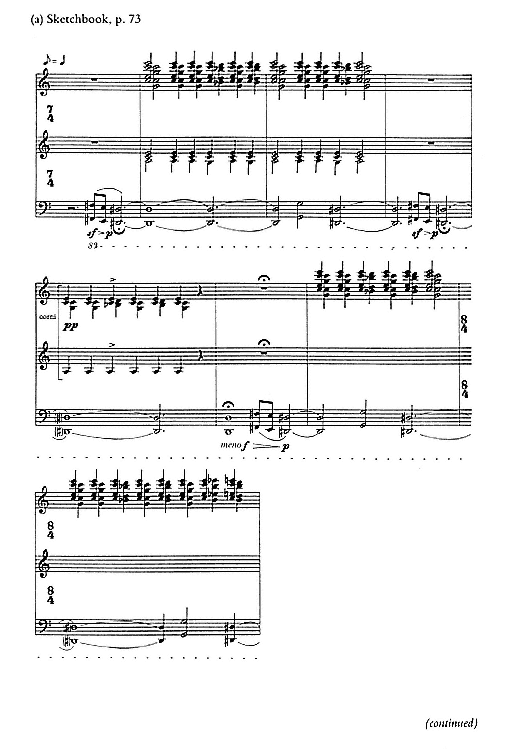
Example 9:
"Evocation of the Ancestors"
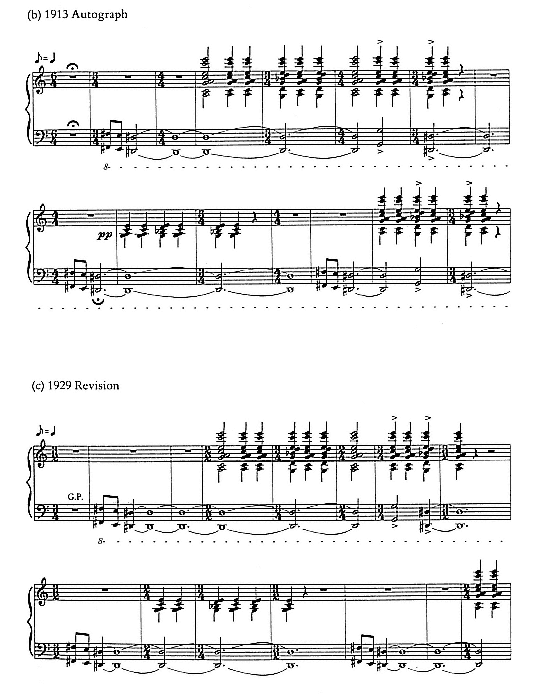
Example 9
(continued)
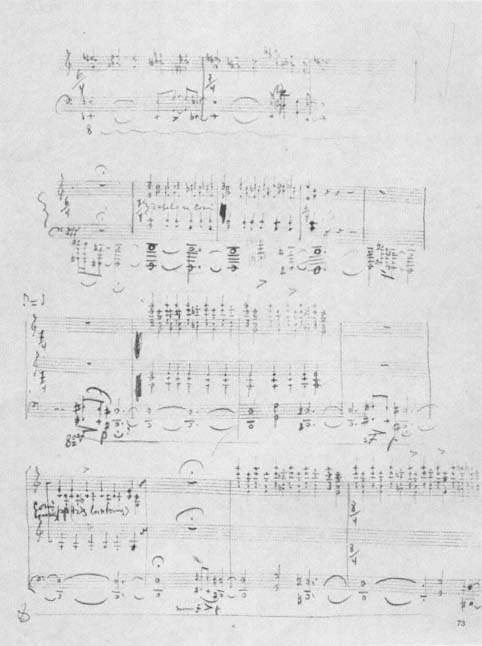
Figure 2:
Early sketches of the "Evocation of the Ancestors," page 73 of the sketchbook of The Rite .
The version transcribed in Example 9a begins at the third line with the

The Rite of Spring (Le Sacre du Printemps) Sketches, 1911–1913, © copyright 1969
Boosey & Hawkes Music Publishers Ltd. Reprinted by permission of Boosey & Hawkes, Inc.
For although the barring of a particular motive may remain constant, this constancy may not always be felt as primary. Upon successive repeats, a motive may assume a changed rhythmic-metric identity, which hinges in turn on the felt presence of a second (concealed) meter.
Much later, in Expositions and Developments (1962), Stravinsky explained that with the longer measures in his earlier versions of both the "Evocation" and the "Sacrificial Dance" he had sought "to measure according to phrasing," but that later on, in 1921, his performance experience had led him "to prefer smaller divisions"; the "smaller divisions," he averred, "proved more manageable for both conductor and orchestra and they greatly simplified the scansion of the music."[50] But as can readily be seen in Examples 9a–9c, the different proportions that distinguish the three versions of the "Evocation" could hardly have been matters of practical convenience. Even if they had, method would presumably have intervened at some point. Observe that the "smaller divisions" of the 1913 autograph in Example 9b are quite different from those of the 1929 revision in Example 9c. Indeed, while the later subdivisions doubtless proved, for conductor and orchestra alike, "more manageable" than the




All the same, Stravinsky's recollection of having measured the "Evocation"'s longer bars "according to phrasing" is revealing. The problem here, however, is that the "smaller divisions" of the 1913 and 1929 versions are really no different in this respect. They, too, are a form of phrasing, even if the conception of this phrasing is different from that of the original sketchbook. Indeed, all three versions of the "Evocation" in Examples 9a–9c introduce the same startling departure in rhythmic-metric design: as in so many of Stravinsky's block structures with irregular or shifting meters, meter and phrasing (or grouping ) coincide. On at least one hierarchical level, meter becomes a form of phrasing while phrasing becomes meter or "measure."
[50] Stravinsky and Craft, Expositions and Developments , p. 147.
The absence of phrase markings in the "Evocation" is to be remarked, as is, throughout The Rite generally, the absence of phrase markings that contradict the bar lines. A more conventional phrasing is found in certain passages of Part II's Introduction and "Mystic Circles"—and it was of course precisely the slow, chromatic lyricism of this music, its evidently non-idiomatic, Debussy-like character, that when compared to the more rhythmically active material of the initial sketches of the "Glorification," "Evocation," and "Sacrificial Dance" proved uniquely difficult for the composer.
What in turn saves this one-dimensional rhythmic-metric approach from sterility are the differing lengths of the juxtaposed blocks upon successive appearances, the lengthening or shortening of the motivic reiteration within these blocks, and the resulting play in rhythmic-metric identity which, although frequently concealed by a shifting meter which graphically preserves identity, lies at the heart of the invention.
Examples 10a–10c further condense the opening measures of the three "Evocation" versions. In Example 10b the subdivisions of the 1913 autograph are closely related to the original

In contrast to the 1913 autograph in Example 10b, the "smaller divisions" of the 1929 revision in Example 10c are a radical departure. Here, the earlier sevens, to which the subdivisions of the 1913 autograph closely adhere, are obscured beyond meaningful apprehension after the first two measures. The rhythm at m. 1 is not preserved at m. 3 as it is in the 1913 autograph, and the 4 + 3 subdivision at mm. 1-2 is not merely reproduced at mm. 3-4. Rather, the 4 + 3 subdivision at mm. 3-4 is now 2 + 3, which means that the shifting meter will actually record the shortening of the motivic reiteration. Hence, too, the termination of the shortened reiteration occurs on the downbeat at m. 5, which will now parallel the downbeat at m. 3. Yet the chief distinction of this 1929 revision is its introduction of the half-note beat as a unit of pulsation,

Example 10:
"Evocation of the Ancestors"
which partially replaces the prevailing quarter-note beat of the earlier versions. This is naturally consistent with the enlarged dimensions of this revision, as discussed above. Then, set against the half-note pulse, the



Stravinsky's conception of "phrasing" seems again very much to the point in the sketchbook version of the second section of the "Sacrificial Dance." As in the preceding illustrations, three versions of the opening measures of this section are cited: Example 11a is from pages 90–91 of the sketchbook,[51] Example 11b follows all editions of the full score beginning with the
[51] The entry on pages 90–91 of the sketchbook is actually a full orchestral draft of the music. This is condensed in Example 11a in order to focus more closely on the barring.
1913 autograph, while Example 11c is from the 1943 revision of the "Sacrificial Dance" alone. As in the three versions of the "Evocation," here the early sketchbook version is characterized by longer measures (or longer "phrases") which in subsequent editions are sliced up into "smaller divisions" (or smaller "phrases"). But notice that the longer groupings of the sketchbook version
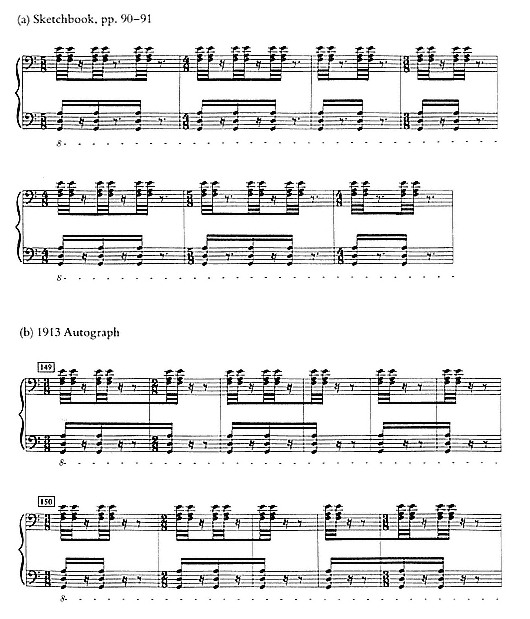
Example 11:
"Sacrificial Dance"
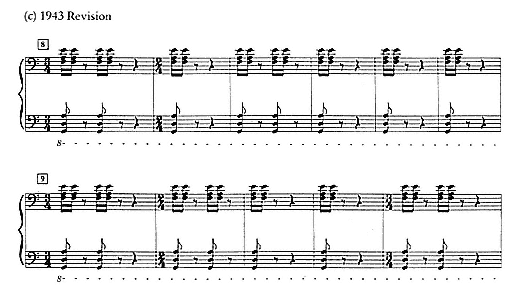
Example 11
(continued)
are preserved in subsequent editions by means of beams that cross the bar lines. The 1943 revision in Example 11c retains the subdivisions but opts for "an easier-to-read unit of beat," which, as Stravinsky later explained, was designed to facilitate performance.[52] Quite simply, eighth-notes become quarters. Yet the disadvantage of the 1943 revision is that the earlier, longer groupings are ignored. Single beams over the bar lines could have preserved some of the earlier connections, but these, too, are sacrificed, presumably in the interests of facility or simple legibility. (The longer groupings or "rhythmic cells" of Examples 11a and 11b are the ones upon which Pierre Boulez based his rather extensive analysis of this passage.)[53]
The idea behind the music at nos. 149-54 in the "Sacrificial Dance" is quite simple. In accord with a single beat or unit of pulsation (the quarter-note in Example 11c), a single chord is punctuated one, two, or three times in succession. These punctuations or successions of punctuations are always separated by a single unit of rest. To a large extent, the metrical subdivisions in Examples 11b and 11c reflect this smaller and simpler conception: the downbeats of these subdivisions coincide with the beginnings of these smaller
[52] Stravinsky and Craft, Expositions and Developments , p. 147.
[53] Pierre Boulez, Notes of an Apprenticeship , trans. Herbert Weinstock (New York: Knopf, 1968), pp. 84-88.
groupings. The exception occurs at the third and fourth measures in Examples 11b and 11c, which, to accord with the simpler conception, should have been combined as a single



The one-dimensional approach noted above applies in all three versions of Examples 11a–11c: with or without subdivisions, meter and phrase coincide, are here wholly "in phase" (to borrow a term from the recent work of Lerdahl and Jackendoff).[54] And the rhythmic play that develops occurs precisely at those points where the groupings are reproduced. In the 1943 revision of Example 11c, the groupings at mm. 3-5 are reproduced at mm. 8-10. Is this metrically exposed repeat heard as such? If not, then we are again dealing with a metrical scheme not graphically in evidence.
As a final illustration, four different versions of the opening measures of the "Sacrificial Dance" are cited in Examples 12a–12d. Once again the sketchbook begins with longer measures which in subsequent versions are subjected to "smaller divisions": the

The 1943 revision also changed the harmony of the very first chord. It began at the outset with the (E












As was indicated above, the 1943 revision of the "Sacrificial Dance" did not become a part of the now widely used 1948, 1965, and 1967 editions of the score. Had a settlement been possible between Associated Music Publishers
[54] Fred Lerdahl and Ray Jackendoff, A Generative Theory of Tonal Music (Cambridge, Mass.: MIT Press, 1983), p. 30.
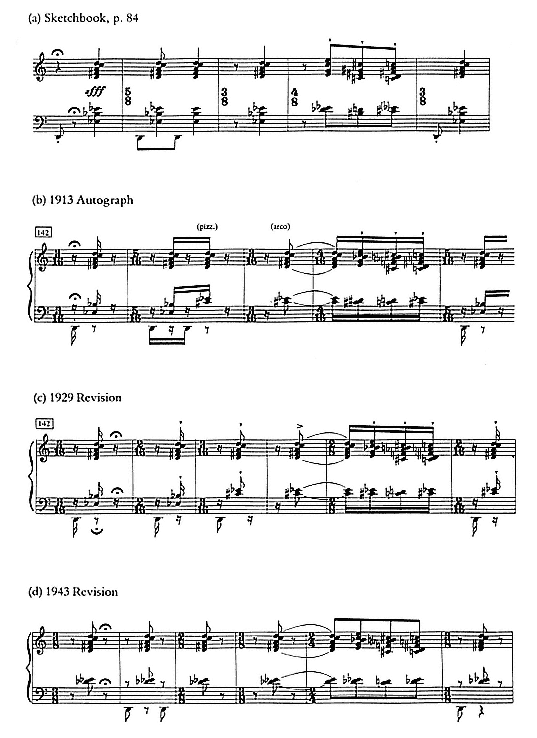
Example 12:
"Sacrificial Dance"

Example 13:
"Sacrificial Dance" Sketchbook, p. 84 1913 Autograph 1943 Revision
and Boosey and Hawkes in the late 1940s and had Stravinsky been willing and able to continue with his revisions for the remainder of The Rite, something like a "final version" might well have emerged as a convenient cap to several decades of incessant tampering. The absence of such a version is to be regretted, all the more since it has placed the 1943 revision of the "Sacrificial Dance" in an awkwardly peripheral position.
Here again Stravinsky no doubt had his reasons. As he later explained, he preferred composing anew to merely recomposing the old: "I would go on eternally revising my music . . . were I not too busy composing more of it."[55] Yet the turbulent history of The Rite 's revisions suggests a nagging dissatisfaction with certain particulars of the music itself. (Stravinsky remained dissatisfied with the final chord of the piece even after the substantial alterations of the 1943 revision.) With so many notes, and with such variety of structure for such a large orchestra, The Rite may have seemed burdened by problematic details that were beyond any conclusive formulation. In the end, Stravinsky may have been put off by the futility of a "definitive" effort.
All versions and editions of The Rite will be taken into consideration in the present inquiry. Ultimate authority rests with the newly engraved 1967 edition of the full score and with the 1943 revision of the "Sacrificial Dance." Yet the earlier versions, especially when in substantial disagreement with the later ones, offer considerable insight into Stravinsky's methods. They will remain points of reference.
[55] Stravinsky and Craft, Expositions and Developments , p. 147. See also V. Stravinsky and Craft, Stravinsky in Pictures and Documents , p. 531, where Craft prints Stravinsky's notations on the margin of a letter from Edwin Stein dated September, 1948. Stein, editor at Boosey and Hawkes, had inquired about the numerous errors in the existing scores of The Rite , to which the composer replied: "Have no time for it. I prefer to compose a new music rather than losing time on this old one."